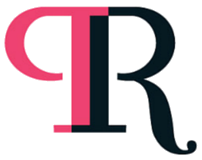
At WritersBlok, clients hire our team of content ninjas to turn their personal stories into brand assets. With our help, leaders and business owners are able to stay relevant in a noisy world, communicate to their audience at scale, and then turn those conversations into profitable leads. While our portfolio is strong-held by manuscripts and keynote speeches, due to the trust we’ve established, the life cycle of our client relationships span several years. During that time, brands often commission us to execute key messaging and communications strategies, across all fronts.
Everyone has a story. The problem, however, is that most people don’t know how to share it in a way that will attract customers, and allow them to stand out against competitors. Throughout my career, I’ve encountered those who hold the misconception that brand storytelling is limited to social media. In actuality, I’m of the belief that business leaders should be integrating storytelling into every facet of their business operations – the boardroom, pitch meetings with potential clients, one-on-one conversations with friends, visual presentations, marketing campaigns (obvi!), and more.
Today, I’ll discuss 10 essential brand assets that I believe will help you strengthen and market your message to land future clients and collaborators. Brand assets are at the root of what makes up your company’s identity. The understanding and prioritization of this has been instrumental in helping me create a steady flow of ready-to-buy clients, essentially creating a blue ocean strategy that makes my competition irrelevant.
REAL-LIFE SCREENSHOT FROM A RECENT EMAIL

But, don’t get it twisted, even if you work in the corporate world, this still applies to you because you are the CEO of your life. I can’t tell you how many times executives have personally reached out to me seeking counsel because they were ready to make a career move, or were recently laid off. The only problem here is that it was only then that they began thinking about brand positioning, reputation management, and thought-leadership.
My advice: Don’t Wait. Get ahead of it.
Brand assets are made up of several elements, including your voice or tone, design elements, slogans or taglines, color palette, packaging, typography, and more. Using my own brand as an example, I’m really excited to show you what I’ve been working on over the holiday break.
Girl, you know I can’t sit still. That was never gun’ happen.
Clients are my priority, and I devote a lot of time to executing their brand goals. But, in order to exceed my own expectations for my brand and company, I knew I had to take a deep dive into my existing narrative and tighten up a few things. I mean, my shit wasn’t wrong but, it wasn’t right either. My dreams and core mission have evolved over time, and the narrative and visuals needed to reflect that. I’ve been building in the public eye since 2010, and because of this, I’ve got a lot of insight to share. To gain a bit more clarity on the new direction I wanted, I had to turn myself into a ‘client’ and ask, “bishhh, what is your 2023 position? What are you really tryna say these days?”
And, that is where it all starts. You have to have a serious conversation with yourself so you don’t end up building a brand trying to follow anyone else’s path. You have to carve out one all on your own, and do it your way.
People ask me fairly often how I’ve cultivated a captivated audience of supporters and a warm and welcoming channel of life-changing opportunities. To this, I always respond: “Women who are changing the world are those who communicate their stories with mastery.”
And, so, with that in mind, let’s get into it. Here’s your reminder to update and upgrade the following:
ELEVATOR PITCH
2017 – While visiting New York City, a friend and I went for a stroll and decided to stop at a coworking space, after our lunch date. Before we entered the elevator, we were interrupted by one of his friends in the building lobby. They shook hands and greeted one another, and when he turned to me, I was greeted with a question. No hello. No smile. In true New Yorker style, he asked, “what do you do?” I opened my mouth with surprise, but I was also very equipped with a response. Because I’d spent the better part of the last few years practicing – in front of the mirror, during long drives home, while cleaning the house – what followed seemed completely natural. “My name is Pauleanna Reid. I’m a celebrity ghostwriter who helps leaders and doers who are shaping the future turn their personal stories into brand assets, so they can stay relevant in a noisy world, communicate to their audiences at scale, and turn those conversations into leads. When clients want to speak up, and shake the room, they call me.”
Immediately thereafter, he said, “I need someone like you,” and within two weeks, I signed my first 5-figure contract, in the sum of $20,000.
There are a few key things to remember here: your elevator pitch should be clear and concise, and should consist of your professional identity, who you help, how you help them, and the transformation they’ll experience as a result of working with you. I also suggest creating a few different pitches to choose from, depending on the room you’re in, who you’re speaking to, and the nature of the conversation.
BTW, you might also like this video: How I gained the respect of a billionaire.
BIOGRAPHY
I get it, biographies can feel super personal, and for some, it can leave you feeling a little exposed. I also empathize with how intimidating it can be when you first sit down to put pen to paper. At some point, I’m sure you may have asked yourself these questions:
- Where do I start?
- What parts of my journey are most relevant?
- How do I articulate so many thoughts on one sheet of paper?
- Where will this bio live online?
- Who really cares?
- When is the right time to write a bio if my career is ever-evolving?
For most people, they wait until the very last minute to get started, only to execute a rush job now that a request has hit their inbox. Why even put yourself through that stress? Today’s note is pretty straight forward, do not wait to get your shit together, because if an opportunity presents itself, you won’t be ready for it. If you keep playing around, you’ll miss your moment. You simply don’t know who’s watching, and what power they hold.
If interested, I can send you a resource with some guiding questions to help you get started, or you can just hire me to write it for you. Either way, shoot me a line.
The last thing I’ll say is that it’s perfectly fine to have more than one biography. Personally, I have four. One two-page biography, and three short bios (ranging from 3-500 words). They all lead with different hats (my work as a mentor, ghostwriter, or journalist) because depending on what room I’m in, I may choose to lead with a different narrative.
The thing to remember is that a bio is your chance to tell your story, your way, so have fun with it. And when you’re ready, I’ll be happy to review yours, and provide feedback, after you’ve given it a try.
E-SIGNATURE
This is an underestimated, and grossly underutilized area, but one I’ve learned to pay attention to. On a typical day, I send anywhere from 50-100 emails. Now multiply that by approximately 30 days every month, and multiply that by 12 months. That’s more than 30,000 eyes on my signature a year, which means that at any given moment, there are one or two things that can capture the reader’s attention. The first is my sign off, “Be brave,” and the second is the hyperlinks I include to my company website and my masterclass workshops. While I can’t guarantee that every single reader will visit those links, if I can garner traction from even the smallest percentage of readers, then that’s just good marketing.
BRAND STYLE GUIDE
Now, style guides can be a simple one-page sheet, or depending on how deep down the rabbit hole you go, I’ve seen decks well into the double digits. On a very basic level, it should include your brand colors, font/typography, and logo.
I’m no designer, but I have enough experience to advise you to stay away from simply choosing your favorite colors to represent your brand. This is a process that requires you to really study your customer, and explore how you would like them to connect with you. According to Wikipedia, color psychology is the study of hues as a determinant of human behavior. Color has the ability to influence perceptions that are not as obvious, such as the taste of food. It even has the ability to evoke certain emotions in people. But the ways that colors influence individuals differ depending on age, gender, and culture, and should be considered in your process. Here are two examples of slides from my own style guides.

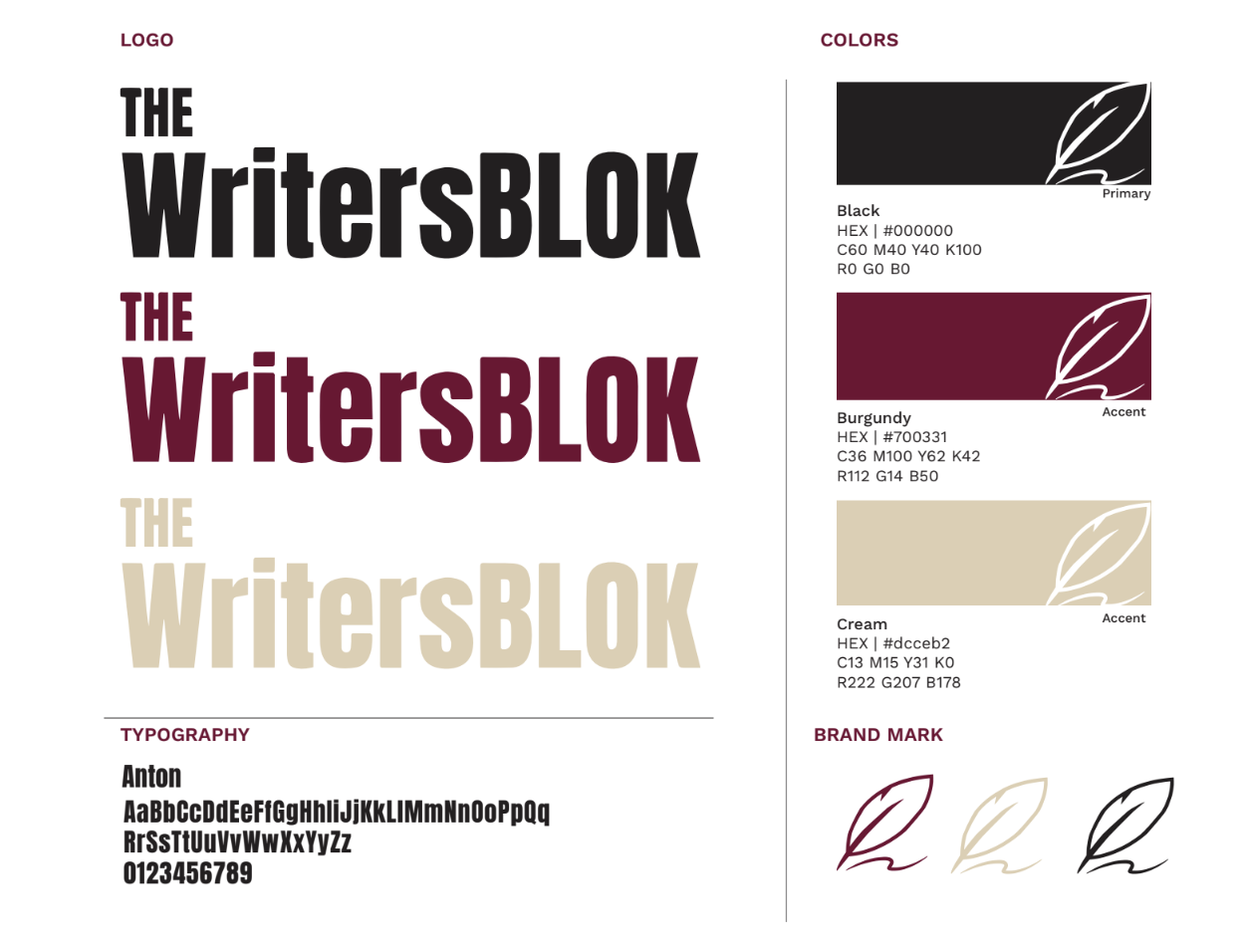
As part of my creative process, I hired a designer to work with me on the overall tone and feel of both my brands; an investment I never regret, no matter the cost. I rather spend the money needed to ensure the highest quality work, rather than revisit it again and again, due to dissatisfaction or misalignment with my brand vision. My personal brand logo was created more than 10 years ago. No matter what I do or where my career journey takes me, it’ll remain timeless. Check it out in the top left corner of my website.
CAPABILITIES DECK
The root word here is capability, which means the power or ability to do something. A capabilities deck acts as a visual presentation that articulates your value. This, I believe, is a crucial part of my brand messaging, as nothing has attracted more business for me than a streamlined flow of my company’s mission, our why, and how our services support the client in solving a business-related problem (click here to view). Now, don’t think this doesn’t apply to you just because you’re a part of the corporate world. You don’t have to own a company to create or benefit from a capabilities deck. Creating one can be a quick and efficient way to demonstrate your personal abilities, too. See two examples below. The first is a slide from my company deck. The second is a slide from my friend’s former deck.
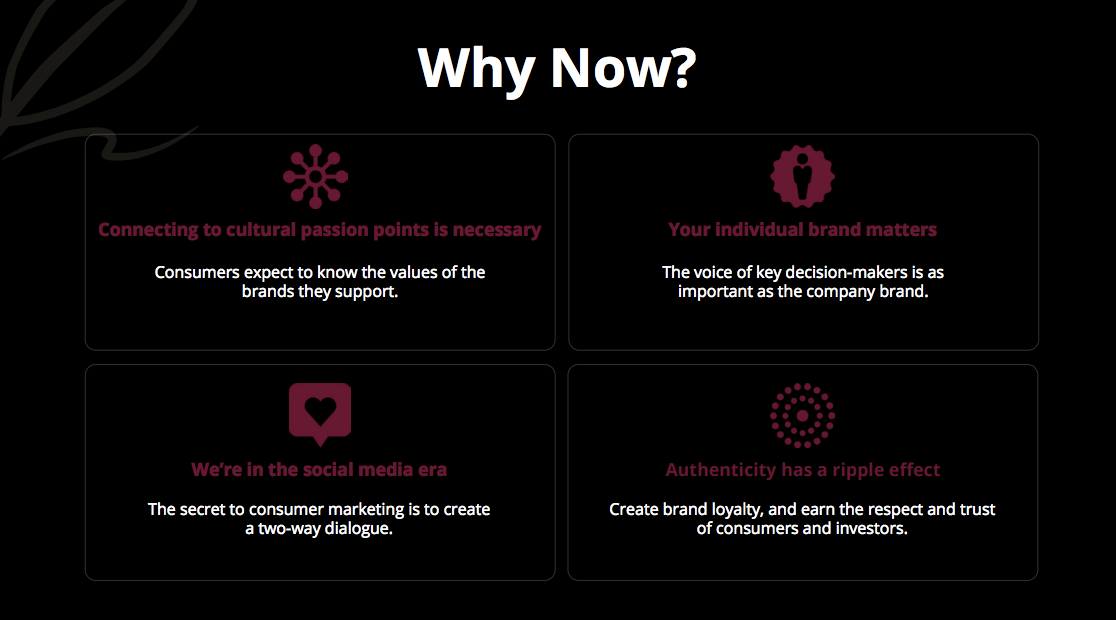
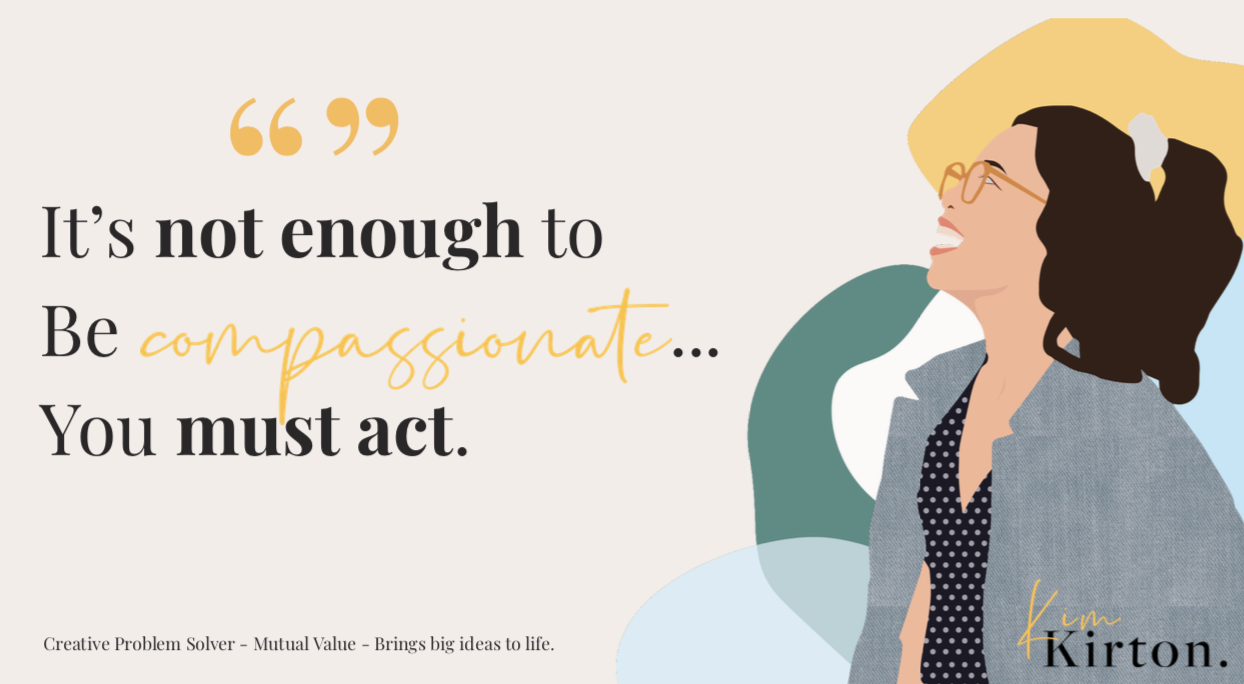
A friend who was on a limited budget once asked me what she should prioritize, a capabilities deck or a website. Without hesitation, I said, “girl, create a deck.” While a website is still a very important asset to have, I do see more traction from my deck. I’ve been told many times that (busy) people appreciate a snapshot view of who you are, as opposed to a website that requires filtering through. Don’t ask me why, that’s just what the streets are saying, and I am in rooms with some pretty big hittas. But, be sure to have fun with your deck. In many ways, it will literally speak for you. Hire a deck designer at WritersBlok, or Google other brilliant women to choose from who specialize in bringing your visual story to life. Some favs who come to mind are Linda Tran and Alyessa Baggetta.
MEDIA KIT
Are you interested in earning media placements? Or speaking on the world’s biggest stages? Then consider creating a media kit. The purpose of this asset is to bring awareness to your brand narrative, while positioning your voice as a go-to expert in your industry. My media kit can be viewed here, and covers the following information:
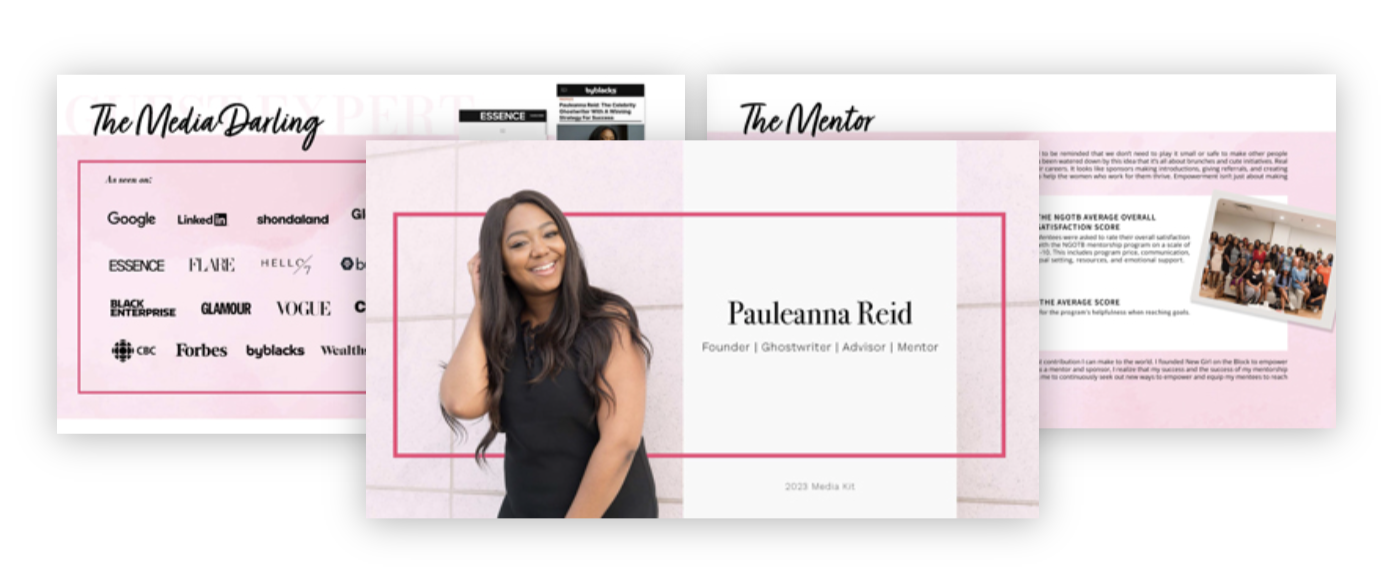
Cover page
Biography
Mission statement
Career breakdown
Case studies / social proof
Media features
Community work
Testimonials
Signature topics
Past speaking engagements
My social media stats
Contact page
When it comes to media kits, I’ve seen formats of all kinds. From a simple one-pager to something more robust, like the one shown above. To get started, you can find plug-and play-templates online, or you can hire our team to customize yours. I’m literally obsessed with mine. I mapped out every detail, and then hired a designer on my team to execute the vision. I loved it so much that I asked my website designer to mimic the same design in a simplified way on the speaking page of my website. Check it out, it’s an excellent example of what we can do for you, too.
DEMO REEL
Early in my career, I made it a habit to film/record all of my speaking engagements. Just like my former days as an athlete, I watched the footage to help me improve my performance. But as my profile evolved, I started posting my engagements on YouTube as a way to build my portfolio. I figured I could leverage it when negotiating my rates because organizers would be able to see first hand how I shift the energy when I walk into the room, speak on stage, and engage with the crowd. Eventually, I curated enough footage to put together a demo reel which I now update every few years. I recently made some changes that you can view here. Just like a media kit and a capabilities deck, stay true to your style. This video could be the difference between earning you $300, $3,000, or $30,000 from your next gig.
RESUME
Most of the creative entrepreneurs I know don’t keep up a formal resume because they utilize their social media and websites to share their work, which is understandable. But the theme here is to create it before you need it. I’m not referring to a formal standard word document, but if the goal is to stand out against competitors, you gotta make it your own. I’m sure glad I did because it was helpful when I landed my literary agent, as it was something she requested before signing me to her roster. Some of the top talent agencies in the world request our ghostwriting services for their clients, and guess what they ask for periodically? An updated resume. Just because you no longer work in a formal job setting doesn’t mean you won’t come across opportunities that will require a resume. Dust it off and keep it updated. Just like a bio, you don’t want to put this shit together last minute, I promise you. It’s the most annoying shit ever.
WEBSITE
Maintaining your website is critical. If it’s been a while since you last took a detailed look at it then there’s no better time than now. Review it page by page and put yourself in your customer’s shoes. Is your website functional and easy to navigate? Is it well designed and functional? Is your copy true to your brand’s voice and personality? Are there clear calls to action? Is your visual content fresh and engaging? Have you made it easy for customers to purchase merchandise or contact you? Is your blog outdated?
FINAL WORD
Last but not least, to amplify your message and increase your conversion rate, ask for testimonials from past clients and also create client case studies. Two very different things. Not just that, make sure you share them on your website and social media. I have more than 125 endorsements on my LinkedIn alone. Your voice can’t be the only confirmation that you can solve a customer’s problem. Nine out of ten clients who schedule discovery calls with me have already made up their mind before we even speak.
The missing key to your business’ success is a well-told story, and the above tips examine several ways in which you can tell yours. Get them started, and make it easy for new leads to trust you, your brand, and what you can deliver.
